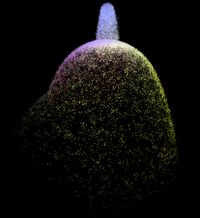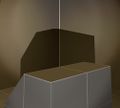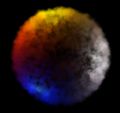Source Particle Benchmark
| This article is non-canon. | ||
|---|---|---|
The subject matter of this article does not take place in the "real" Half-Life and Portal universe and is considered non-canon. |
The Source Particle Benchmark, also known as the Multicore CPU Particle Simulation Benchmark, is a late 2006 benchmark which introduced some of the new and more advanced features of the Source engine and Valve's hybrid threading technology, such as dynamic shadows and particle-based effects, and their performance on multi-core processors. It contains several scripts, models, textures and a single demonstration map where five rooms can be visited, four of which containing particle effects. As part of a larger series of several benchmarks (see below), it was given by Valve to some visitors at GDC 2007,[source?] as well as other people.[1]
Overview[edit]
- The Source Particle Benchmark pack consists of three folders:
- The first, named
map compilation benchmark, allows to compile a map set in the Episode One Citadel,ep1_citadel_03, through the filebuild_map.batto see how long it takes for the used computer to compile a map.[1] As it is not to be played, the map is incomplete. - The second folder, named
particle simulation benchmark, contains the main test map,particle_benchmark, where the particle effects are showcased (to be launched with the fileparticle_benchmark.batlocated in the subfoldergame). To view them, the player has to trigger them with a button with under it the sign "Particle Benchmark", conveniently placed in the middle of the central room connected to the four other rooms, then a demo will showcase the four effects in their respective rooms. The player can also walk into the rooms to view the effects from different angles. When all effects have been viewed with the button, a benchmark score named "Particle Performance Metric" is displayed on the top-right of the screen. This is a representation of the amount of particles per second (in thousands) that the CPU is able to calculate.[1] If the player has a highly equipped computer, the score will be high (more than 100, for instance). If not, the score will be low (around 35, for instance). - The third and last folder,
presentation slides, contains a PowerPoint presentation, namedmulticore_hardware_day.pptand dated November 1st, 2006, about the new features of the Source engine, and their relation to multi-core processors. All files are dated October 27, 2006 or November 1st, 2006.
- The first, named
- In the Particle Benchmark script files, some information about the early stages of the development of Half-Life 2: Episode Two can be found:
- The file
level_voices_episode_02.txtshows that two characters cut from the final game, Cyril and Fred, are mentioned. They were to be seen in the mapoutland_06near the bridge where the Muscle Car is found, and say several things together and to the other protagonists. - The file
level_voices_episode_02.txtalso reveals that the G-Man heart-to-heart monologue with Gordon Freeman originally was to be much longer. - The file
level_voices_episode_02.txtalso contains the sound files related to Alyx Vance's fall at the start of the game in the mapoutland_01, featured in the first Episode Two teaser trailer. - The previous elements are still present in the version of
level_voices_episode_02.txtfound in the retail Episode Two files. - A dedicated rain sound existed at some point, to be located in
sound/ambient/levels/forest/rain_loop1.wavand possibly hinting at a planned rainy level for showcasing particle effects. - The background texture used in the Particle Benchmark menu appears to be a blurred screenshot of an early location called Riverbed.
- The file
- A colored entity named
npc_surface, used to simulate dynamic liquids, can be spawned using a console command "give npc_surface". Interestingly, its model is namedHydra.mdl, but it appears to be different and cannot be found in the files. When touched, it takes away 5 health points. Hydra textures can also be found in the texture files. According to Erik Wolpaw, the experiment behindnpc_surfacewas applied to the Mobility Gels in Portal 2, with additional influence from Tag: The Power of Paint.[2] - Another entity,
npc_blob, can be spawned in-game. The model is broken, and it appears as several "ERROR" models jumping randomly. When spawning, the console displays "Late precache of models/headcrab.mdl" and "Late precache of models/w_squeak.mdl", suggesting a relation with the Headcrab and the Snark. Copy/pasting the Snark model from Half-Life: Source in the model files replaces the "ERROR" model, showing the proper result, thus Snarks jumping randomly. It does not hurt the player. It appears that this entity was used for another similar demonstration, Dynamic Environmental Interaction, showing Snarks' reaction to environment objects. - The console reveals that the username in use is "ErikJ", or Erik Johnson, project manager at Valve.
- The CFG file
leipzig.cfgfound in the files, and also featured in the Episode Two files, lists the five Episode Two "Gameplay Videos" showcased in September 2006.[3] - In the folder
demoof the Episode Two texture files can be found more other demo signs, showing that the Particle Benchmark was only one of many demos. They include "Adaptive Density", "AI Test Lab", "Chow Time", "Complex Collision Detection", "Dynamic Environmental Interaction", "Physics Integration", and "Precision + Coordination". The Particle Benchmark sign can also be found there, but it is spelled "Particle Simulation Benchmark" instead of "Particle Benchmark". - Two Source Filmmaker movies created in Half-Life 2: Episode One can be found in the "episodic\elements\sessions" directory.
- The file
ep2\reslists\unreferenced_files.lstlists all Episode Two files existing as of October 2006.
Gallery[edit]
Background menu texture, showing a location called Riverbed.
References[edit]
- ↑ 1.0 1.1 1.2 Valve Software's Source Engine Multi-Threaded Preview on [H]ard|OCP (November 6, 2006) (archived)
- ↑ Portal 2 Preview on Edge Magazine (March 18, 2011) (archived)
- ↑ Episode Two video playlist on YouTube










